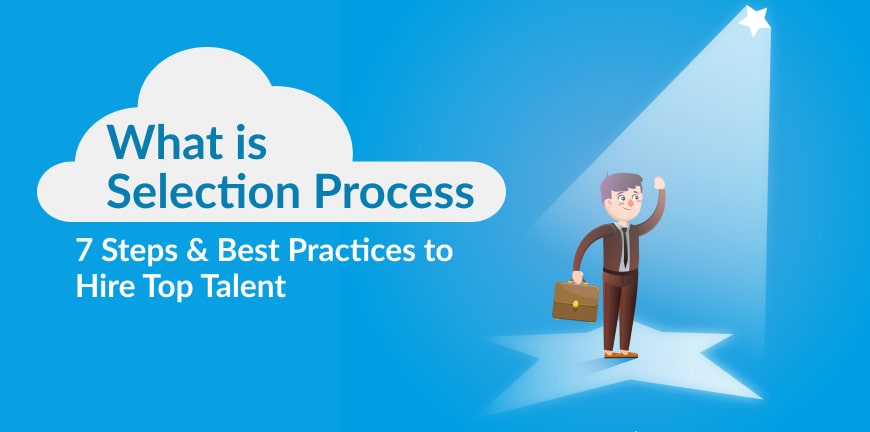
What is Cloud Compliance? A Comprehensive Guide
27/05/2025
Cloud Compliance Security Checklist: Key Elements
31/05/2025For businesses whether a startup or Fortune 500, a robust workforce ecosystem is critical for business continuity. To maintain the balance of this ecosystem, employee retention efforts and filling vacant positions with new talents in a short duration are key.
However, to recruit the best candidates from a wide talent pool across India, deploying a robust selection process can be a game changer for both the company’s business endeavours and the candidate’s career aspirations. Let’s discuss the 7 stages of the selection process that most successful companies follow to onboard top talents across their organisation.
What is the Selection Process?
In the recruitment context, we can define the selection process as a “systematic and strategic approach to scout and select best candidates from a set of job applications received from different sources to fill a vacant position for a specific role in either technical or non-technical domains”.
A selection process in HRM starts when a company posts a job requirement through various platforms like social media, job portals, company websites, etc.
Typically, there are 7 stages in the recruitment and selection process that most companies or HR agencies follow for best results. It follows a funnel structure where from hundreds of applicants it progressively gets filtered out to a handful of candidates making it to the final rounds of selection.
Finally, the best candidates will be selected based on the positions available with 2 or 3 backup options in case the best candidates don’t accept the job offer. The stages of the selection process include:
- Receiving applications from candidates matching to JD (Job Description)
- Initial screening and shortlisting of potential candidates
- Interview
- Assessment
- References and background checks
- Final Decision on offering the job
- Job Offer and Agreement.
What is the Importance of a Strategic Selection Process?
Here are the reasons that shed light on the importance of a strategic selection process:
1. Onboarding Skilled Employees
As we know hiring skilled employees is half the battle won for companies looking for long-term success and continuous growth. A robust recruitment selection process will ensure only top talents with high skills and expertise are recruited and onboarding leading to higher productivity and accelerated growth.
2. Prevents Business Disruptions
A streamlined and robust selection process ensures job positions are filled in a short duration without compromising on the quality and skills of the hire, preventing business disruptions due to workforce shortages.
3. Hire candidates matching the company’s culture
Hiring candidates that are best fit for the company’s culture is crucial to ensuring long-term association and creating a positive working environment. The selection process must include this criterion before the final decision is taken for offering a job for a candidate.
4. Improving brand reputation
A company’s success is measured by its brand reputation and a strong employee team is the key to improving it. The hiring team with guidance from the leadership group must create strategies to recruit top professionals who have the vision to support the company’s brand improvement goals along with their career aspirations.
5. Higher productivity and employee retention rates
The main objective of a selection process is to recruit candidates who can ensure higher productivity and stay in the company for the long term. All the stages of the selection process must be strategically mapped out to increase the chances of recruiting the best candidates that work diligently to help the company achieve their business endeavours in the smartest way possible.
7 Key Steps in the Selection Process
Here are the 7 key steps in selection process in HRM that most companies adopt to recruit top candidates to fill a job vacancy:
1. Receiving Job Applications
Once the recruitment team posts a job opening with a detailed JD (Job description on various job platforms, passive candidates with profiles matching the JD will start applying for the job. Alternatively, the HR professionals will use different methods to identify potential candidates and send them job application invites through email or WhatsApp applications.
The number of applicants received will vary based on the company size, type of role, employment type (permanent or contract), brand reputation, location, work mode (WFH, Work from Office, or hybrid roles), and other factors. A popular job role may receive hundreds to thousands of applications whereas niche roles may receive fewer applications.
A confusing or generic JD can lead to a large influx of applications with the majority of them not matching the requirement. Therefore, the HR team must ensure that the JD is detailed and accurate with clear expectations to ensure applications are received only from the matching profiles.
2. Initial screening and shortlisting of potential candidates
It is one of the most critical stages of selection process. Once the applications are received from candidates that include updated resumes and portfolios (required for some job roles), the HR team must carefully vet the details as a part of the initial screening process.
The resumes provided by the candidates must be weighed against JD to filter and remove the profiles that are not as per the requirements. Ex: If a job role requires 5 years of experience and a fresher has applied, then the profile is considered as mismatch and removed from the probable list.
If the number of applications is too many, then use an automated resume filtering system like ATS (Applicant Tracking System) to shortlist the best candidates. Once the list is prepared, the HR team must contact the candidates via phone or online meeting tools (Microsoft Team, Google Meet, etc.) to get an initial brief on their interest in pursuing this role, current expertise and skill level, notice period, availability for the next stages of selection process, current company, reason for job change, current and expected CTC, etc.
Based on the conversation and judgement of the HR professional, the candidate list can be filtered further to ensure only the best-fit ones are considered for the next round of the selection process.
3. Interview
The third step of the selection process in HRM which involves maximum interaction between the recruitment team and the candidates is the interview round. In this step, the shortlisted candidates are invited for an interview either offline or online based on company requirements. The interview round might have different stages like the technical rounds, GD Group Discussion), and HR rounds. The interview flow will be decided by the HR team or the project manager.
This round is crucial for both the prospective candidate and the hiring/project manager since the interactions can provide valuable insights that can lead to the final decision of selection or rejection based on performance. The assessment team will conduct a detailed evaluation of the candidate’s expertise, skill level, communication level, etc., through general and technical questions, scenario-based discussions, and other interview techniques.
On the other hand, the candidate seeking a job change can get a glimpse of the company’s work culture, expectations, and career growth trajectory by having an in-depth conversation with the interviewer. If the candidate successfully cracks the interview, he/she will be selected for the assessment round.
4. Assessment
Once the number of candidates is filtered to 3 OR 4 (in case only 1 position is available) after the interview stage of the HR selection process, the recruitment team proceeds to conduct assessment tests to rank the best among the selected candidates. This stage of the selection process will remove ambiguities and help the recruiting team to get clear insights on each candidate’s ability and skills acquired from their current and previous job experiences.
Typically, assessment tests include a personality test, behavioural assessment, situational judgement tests, verbal reasoning, behavioural assessment, role-based tests, etc. Although detailed assessments can be time and resource-consuming, they function as a great tool for hiring managers to assess candidate’s expertise and problem-solving skills in the real world and real-time scenario leading to best quality hire.
5. References and background checks
This step in the selection process acts as a verification tool to ensure the right candidates are selected for the vacant positions. Through references to previous firms’ managers and team leads the hiring team can get clarity on the candidate’s positive and negative attributes, validate the skills mentioned in the resume, and confirm the employment status (joining and exit date).
Additionally, background checks like address verification, identity verification, checks for criminal cases, previous employments, etc., will help the recruitment team verify the details provided in the resume against the reality.
6. Final decision on offering the job
Based on the performance and results of the previous stages of selection process, the recruitment team will make the final decision and offer the job to the best candidate as per their assessment. They will also keep 2nd and 3rd options open from the final list in case the best candidate rejects the job offer or fails to join the company within the mentioned deadline.
7. Job Offer and Agreement
Once the final decision is made, the hiring manager will offer the job to the selected candidate through an official email. A preliminary offer letter with salary breakup and terms & conditions, joining day, and other details will be given to the candidate and the same must be accepted and acknowledged through an acceptance mail.
Any queries from both parties must be addressed before the onboarding process is initiated. Suppose the candidate rejects the offer at the final moments or is unable to join due to unforeseen circumstances, the HR team must find alternatives and fill the positions with the 2nd and 3rd best candidates who were kept as a backup.
Best Practices to Improve the Selection Process
Here are the best practices to improve the selection process in HRM:
1. Provide comprehensive job description (JD)
The recruitment must provide a comprehensive JD that outlines the job designation, roles and responsibilities, years of experience, skills required, software used, tools required, compensation offered, work mode, location, etc. Both candidates and recruitment must set clear expectations to derive the best outcomes.
2. Structured interview process
The hiring team or the management must develop a concrete strategy-based structured process with a proper flow that provides fair opportunities for candidates to showcase their skills and abilities, ensure transparency, and maintain consistency and objectivity throughout the process.
3. Leverage Technology
Use AI and other automated technologies like ATS (Applicant Tracking System) to reduce human intervention, save time, and resources and streamline the recruitment and selection process.
4. Improve Candidate Experience
Whether a candidate gets recruited to be a part of the company or otherwise, providing a seamless interview experience through a robust selection process is non-negotiable to attract top talents and maintain business continuity.
5. Diversity and Inclusion
The selection process in HRM must include strategies that integrate diversity and inclusion practices to provide equal opportunities for all leading to better complaint and enhanced brand reputation.
Metrics to Track in the Selection Process
Certain recruitment metrics will help the hiring team evaluate the results of the employee selection process and make improvements for better outcomes. The typical metrics used for assessing the recruitment and selection process in HRM include:
1. Time-to-hire
This metric helps in measuring the time spent between the job posting to job offer acceptance giving an insight on the effectiveness of the selection process.
2. Time-to-fill
This metric measures the time taken between job posting and onboarding a candidate to fill the vacant position.
3. Quality of hire
Once the candidate is selected and onboarded, quality-of-hire metrics starts counting. The long-term impact of the new hires is assessed via performance, productivity, revenue growth, and retention rates which in turn will vary the quality-of-hire metrics whether it was a success or not.
4. Cost-per-Hire
This recruitment metric helps in tracking the cost associated with new hires from job posting to onboarding, helping the recruitment team to create strategies to reduce costs for future hires.
5. Offer Acceptance Rate
This metric will help the HR team gain insights how many candidates accepted the job offer vs. the total candidates shortlisted for the interview round.
Are you Looking Recruitment Partner?
Building a diligent and seamless selection process that yields nearly a 100% job acceptance rates with the help of an in-house expert team can be tedious and expensive. Also, getting best outcomes on a regular basis with an in-house team that is multitasking is extremely challenging. Therefore, partnering with a highly reputed recruitment agency like ALP Consulting can give a competitive edge to companies seeking exponential growth and enhance their brand reputation. The key advantages of collaborating with ALP include:
- Recruitment of top talents for all niches in short duration
- Nearly 30 years of field expertise in handling end-to-end recruitment and selection processes.
- Highly dedicated and experienced HR professionals’ team.
- Equipped with the latest technical advancements for streamlining the HR selection process.
- Pan India presence
- End-to-end post-recruitment services from onboarding to compliance.
Key Takeaways
- A 7-step selection process developed with diligence helps companies select and onboard best-fit talents across various domains in short duration without any hiccups.
- Accurate job descriptions and role clarity significantly elevate applicant quality, reducing the chances of bad hires and enhancing the overall selection process experience.
- Using tools like ATS and assessment tests ensures objective candidate evaluation, boosting selection accuracy and time-to-hire efficiency.
- A positive working environment brimming with growth opportunities across domains and strong candidate interview experience are critical for long-term employee retention and maintaining brand reputation.
- Collaborating with a highly reputed recruitment solutions provider like ALP Consulting can be a game changer for companies whether a rookie or a market leader, giving them a competitive edge and access to a top talent pool across India.
Frequently Asked Questions (FAQs)
1. What is the selection process?
The selection process meaning in the context of recruitment states that ” A selection process is a systematic and structured approach to successfully recruit top candidates to fill vacant positions once a job requirement is established and posted on various job platforms and websites.”
2. Why is a strategic selection process important?
A selection process in HRM is essential for recruiting and onboarding top talents in a short duration to drive sustained success for an organisation on a long-term basis.
3. What are the main steps in the selection process?
The specific steps involved in the selection process include receiving applications from candidates matching to JD (Job Description), initial screening and shortlisting of potential candidates, interview, assessment, references and background checks, final decision on offering the job, and job offer & agreement.
4. How do you conduct an effective candidate screening?
For effective screening of candidates to fill vacant positions, the recruitment and selection process team must use a streamlined screening approach that involves defining clear hiring criteria, creating a structured and consistent screening process, evaluating candidates by thoroughly vetting their resumes and portfolios, and shortlisting the best-fit candidates for further interviews.
5. What is the difference between recruitment and selection?
Recruitment is a broader term that includes the entire process of posting a job to onboarding candidates who have successfully cracked the interview. On the other hand, a selection process is part of recruitment where once the job requirement is advertised on various platforms, candidates go through various stages of selections and the best ones who clear all the round receive job offers.




